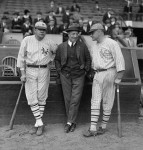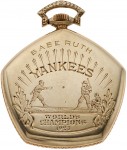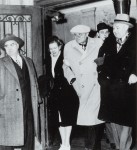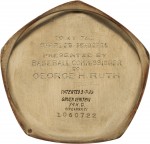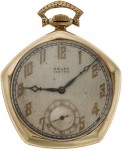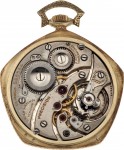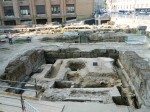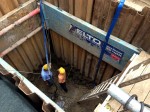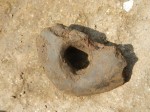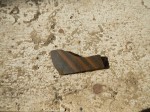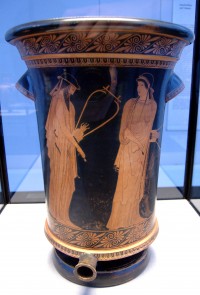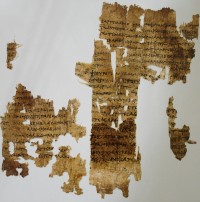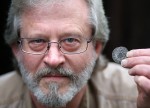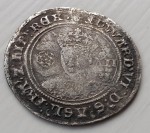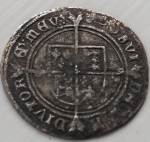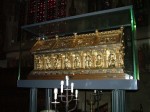 That may seem obvious, but given how often he was exhumed and reburied and parts of him given away as relics, it’s actually quite notable that the collection of bones in the Karlsschrein, the Shrine of Charlemagne, and other reliquaries in the Aachen Cathedral all appear to come from the same person who matches contemporary descriptions of the Frankish king.
That may seem obvious, but given how often he was exhumed and reburied and parts of him given away as relics, it’s actually quite notable that the collection of bones in the Karlsschrein, the Shrine of Charlemagne, and other reliquaries in the Aachen Cathedral all appear to come from the same person who matches contemporary descriptions of the Frankish king.
Charlemagne died almost exactly 1200 years ago, on January 28th, 814, and was buried in the choir of the Palatine Chapel in Aachen Cathedral. (See Einhard’s Life of Charlemagne, written 15-20 years after his death for a description.) In 1000, Otto III, keen to present himself as the successor of the great man, had the burial vault opened. According to German chronicler and bishop Thietmar of Merseburg who was a contemporary of Otto’s, when the vault was opened they found Charlemagne’s uncorrupt body seated upon a marble throne wearing a crown with a scepter in his hand and the gospels open in his lap. Otto reportedly Helped himself to some of the relics and brought them to Rome.
![]() Frederick I Barbarossa was the next to disinter Charlemagne. In 1165, he had the remains exhumed and displayed as holy relics at the Aachen Court festival. Again this was a means for Frederick to establish a connection with the revered leader and to position Aachen as a center of pilgrimage like St. Denis or Westminster. To curry favor with Frederick, Antipope Paschal III canonized Charlemagne that same year, although this, like all of Paschal’s acts, was never recognized by the Vatican. Barbarossa had Charlemagne’s remains reburied, this time in an elaborate third century A.D. Roman marble sarcophagus depicting the Rape of Persephone, which may seem incongruous as a topic for Christian burial, but like many ancient myths was re-interpreted as a symbol of Christ’s resurrection.
Frederick I Barbarossa was the next to disinter Charlemagne. In 1165, he had the remains exhumed and displayed as holy relics at the Aachen Court festival. Again this was a means for Frederick to establish a connection with the revered leader and to position Aachen as a center of pilgrimage like St. Denis or Westminster. To curry favor with Frederick, Antipope Paschal III canonized Charlemagne that same year, although this, like all of Paschal’s acts, was never recognized by the Vatican. Barbarossa had Charlemagne’s remains reburied, this time in an elaborate third century A.D. Roman marble sarcophagus depicting the Rape of Persephone, which may seem incongruous as a topic for Christian burial, but like many ancient myths was re-interpreted as a symbol of Christ’s resurrection.
He didn’t stay there for long. In 1215, Frederick II had Charlemagne exhumed yet again. He commissioned local goldsmiths to make a rich gold casket to hold the bones. That’s the Karlsschrein originally in the placed in the center of the Palatine Chapel underneath a chandelier donated by Frederick Barbarossa in 1168.
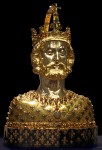

 Nearly 200 years passed before the next king inserted himself into Charlemagne’s eternal rest. In 1349, some of his bones were removed to individual reliquaries by Holy Roman Emperor Charles IV. He had a gold reliquary made to contain a thigh bone, and the Bust of Charlemagne to contain the skullcap. Louis XI of France contributed to the trend in 1481 by commissioning the Arm Reliquary, a golden arm that contains the ulna and radius from Charlemagne’s right arm.
Nearly 200 years passed before the next king inserted himself into Charlemagne’s eternal rest. In 1349, some of his bones were removed to individual reliquaries by Holy Roman Emperor Charles IV. He had a gold reliquary made to contain a thigh bone, and the Bust of Charlemagne to contain the skullcap. Louis XI of France contributed to the trend in 1481 by commissioning the Arm Reliquary, a golden arm that contains the ulna and radius from Charlemagne’s right arm.
It was scientists who took over from the emperors and kings. In 1861, Charlemagne’s remains were exhumed again so they could be studied. His skeleton was reconstructed and a very generous estimate (1.92 meters, or 6’4″) made of his height. In 1988, scientists exhumed his remains one more time, this time in secret. This study covered the bones in the reliquaries as well, a total of 94 bones and bone fragments, and they spent years meticulously examining and testing the collection. On Wednesday, January 28th, the 1200th anniversary of Charlemagne’s death, the results of the research were announced.
One of the scientists studying the remains, Professor Frank Rühli, said: “Thanks to the results from 1988 up until today, we can say with great likelihood that we are dealing with the skeleton of Charlemagne.”
From studying the dimensions of the upper arm, thigh and shin bones, scientists have built up a picture of the man behind the skeleton, and it matches descriptions of Charlemagne.
At 1.84 metres (six feet), he was unusually tall for his time. The team also estimated his weight at around 78 kilograms, giving him a slim body mass index of around 23.
The average height for an adult male in the 9th century was 1.69 meters or 5’6″, which put Charlemagne in the 99th percentile. Einhard’s description of him fits the results of the study even in some of the smaller details, like the limp that struck him in his later years. Researchers found that the kneecap and heel bone had deposits consistent with an injury.
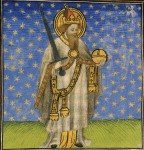 From Chapter 22 of the Life of Charlemagne:
From Chapter 22 of the Life of Charlemagne:
Charles was large and strong, and of lofty stature, though not disproportionately tall (his height is well known to have been seven times the length of his foot); the upper part of his head was round, his eyes very large and animated, nose a little long, hair fair, and face laughing and merry. Thus his appearance was always stately and dignified, whether he was standing or sitting; although his neck was thick and somewhat short, and his belly rather prominent; but the symmetry of the rest of his body concealed these defects. His gait was firm, his whole carriage manly, and his voice clear, but not so strong as his size led one to expect. His health was excellent, except during the four years preceding his death, when he was subject to frequent fevers; at the last he even limped a little with one foot.
